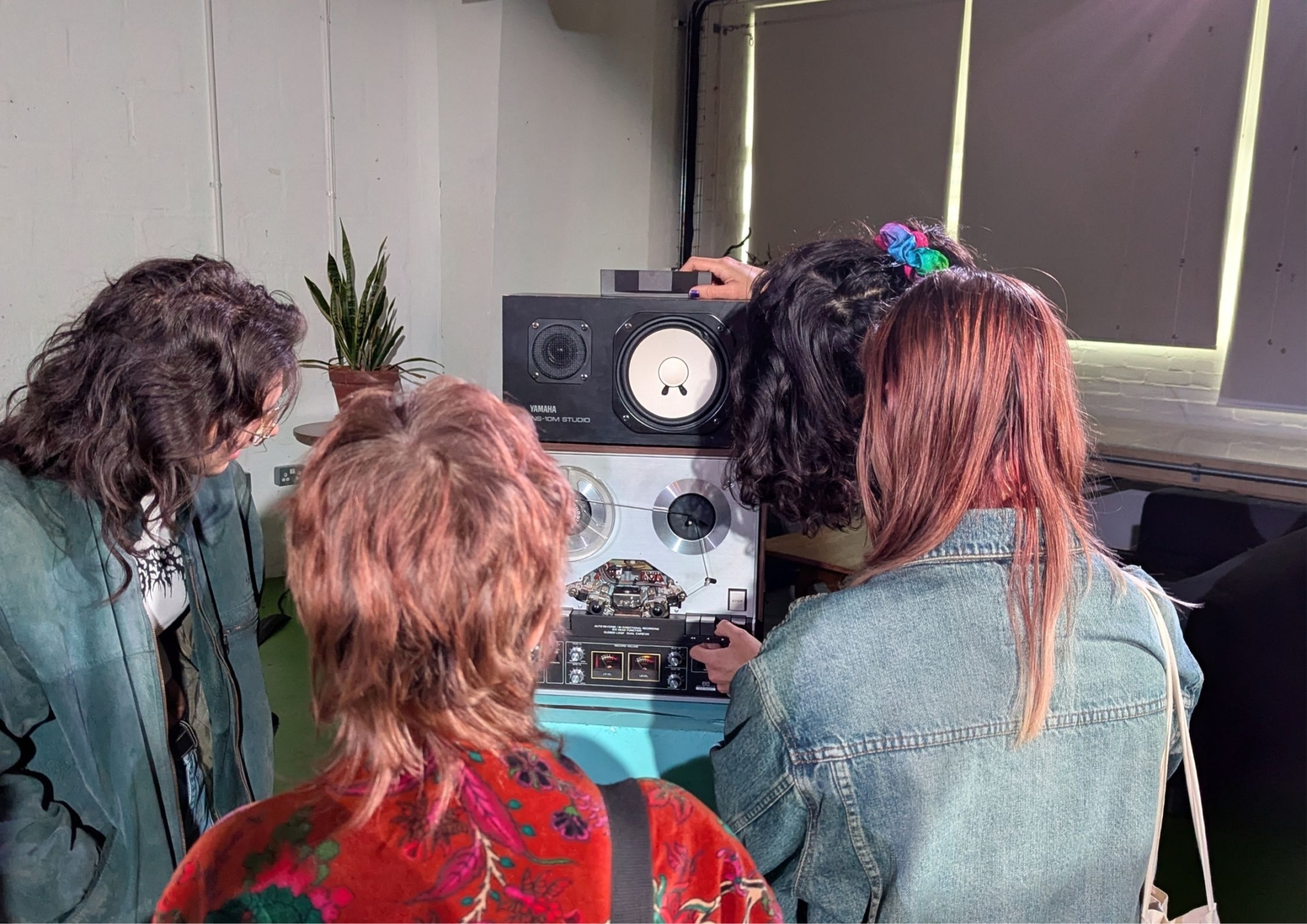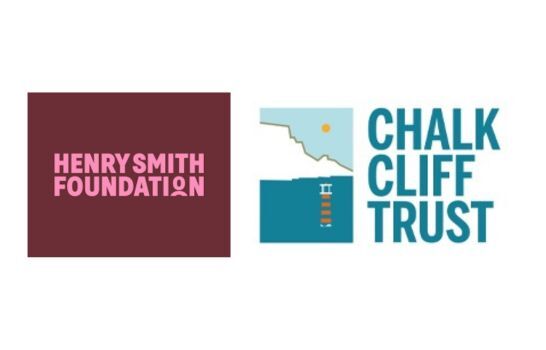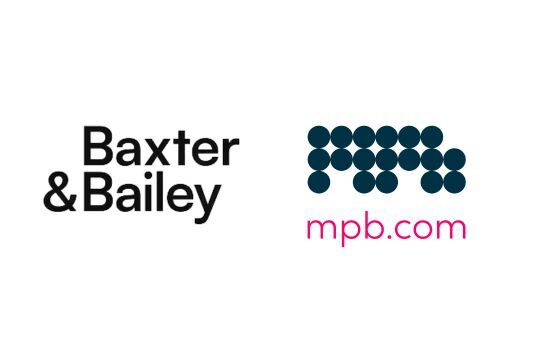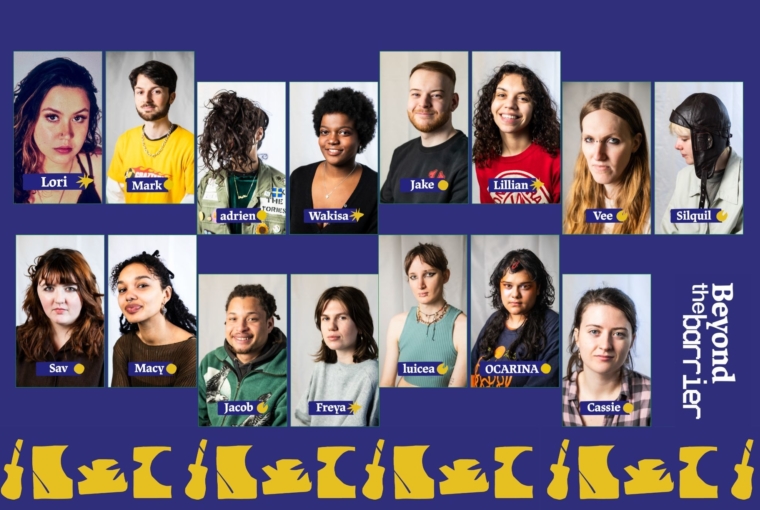
Degrade by adrien châtelain, a Lighthouse Young Creatives alum
In September this year, Lighthouse Young Creatives (LYC) alumn, adrien châtelain held an immersive and thought-provoking sonic arts installation, made up of five reel-to-reel tape machines playing different loops to produce unique compositions.
Degrade is designed to prompt the audience to reflect on the damaging cycles of consumption, causing the climate catastrophe and was produced with technical consultancy from Alex Johnson, with support from Lighthouse. It was shown over four days at at the Lighthouse Project Space.
We caught up with adrien to explore the artist’s work, inspirations behind Degrade, Lighthouse’s support, the influence of the LYC community on their development, and how their practice is evolving as they look towards future projects.
Tell us a little bit about your work, Degrade?
"Degrade is a responsive audio arts installation that interrogates our collective relationship to the climate catastrophe through tape loops. The piece is made up of a set of reel-to-reel tape machines positioned around the audience, each playing a different loop of birdsong and sound I composed, reflecting natural cycles. The machines detect your position and, based on your proximity to each one, push sandpaper against the loops, degrading and destroying them over time.
The net effect of Degrade is that, over a period of time, visitors to the space take part in the destruction of the artwork simply by being there and engaging with it. The project is designed to prompt the viewer to reflect on the collective damage caused by the cycles of extraction and consumption in the human world, and their place in it - their damage as an individual is barely perceptible, but over time the visitors’ impact adds up until the tape is destroyed entirely.
At first, the audio begins to degrade, losing fidelity and higher frequency sounds, then it starts hissing, stretching and cutting in and out before, ultimately, failing completely. The loops are all different lengths, so the sounds shift and move in and out of time with each other, a process that’s accentuated by the loops stretching and deforming over time, pulling them out of time and pitch. The result is a haunting, ethereal composition centering around birdsong gradually being silenced."
What were the key inspirations or starting points for Degrade, and how does it connect to your broader artistic practice?
"I’ve been working on Degrade for a few years now, and there are a few key inspirations that led me down the path of tape loop experimentation and degradation in particular. I’ve long had an interest in analogue technology - the physicality, idiosyncrasies and limitations generally feel intuitive and grounding for me, from synthesizers to film cameras to tape machines.
After learning more about the history of recorded music and tape in particular, I found an old consumer tape machine (a Grundig TK-14) in my grandparents loft. Researching more into the medium I discovered acousmatic music and musique concrète which immediately caught my interest; I was particularly drawn to Alvin Lucier, Pauline Oliveros and Steve Reich’s work with tape loops which informed Degrade - pieces like I Am Sitting In A Room which exploit the relationship between sound and space through the recording medium, Reich’s shifting looping compositions and Oliveros’ approach to deep listening were all key influences.
Reading about the degradation process for tape was also vital - in servicing the Grundig, I learned that the murky brown residue that builds up on the tape heads is in fact the ferrous magnetic material that carries the sound itself, slowly stripping itself away through its movements through the machine. Another relevant piece is William Basinski’s Disintegration Loops, where he discovered that long-repeating loops through his cassette machine gradually lose fidelity until their destruction - though I only discovered this after planning out Degrade.
In addition, learning about generative music helped cement the use of multiple machines playing different lengths of loop so they shift in and out of time with each other, creating similar but never quite repeating compositions.
My broader artistic practice includes a focus on installation and immersive environments where audience interaction plays a key role - even traditionally one-sided artforms such as my music and performances often include a level of interplay between the work and the audience, implicating them in the subject matter of the songs. The interactive and responsive elements of Degrade expand on that, putting attendees in the position of participants where their actions (individually and to a much greater extent collectively) shape and converse with the artwork. Much of the rest of my work focuses on the climate catastrophe, decay, and textures; with attention paid to the interplay between the medium and the work e.g. using analogue film to accentuate noise and grain/to detect radiation artefacts, or making paper from plants to give specific textures to prints, so Degrade fits in well with the rest of my practice."
What role did Lighthouse play in helping you realise your artistic vision for Degrade?
"I was part of the 2024-2025 Lighthouse Young Creatives cohort, which was immensely helpful for completing and exhibiting Degrade, despite not actually working on it during that time!
The programme was a massive confidence boost - everyone was immensely supportive and encouraging, and the mentors and Lighthouse staff in particular were always receptive to my ambitious ideas, discussing and nurturing concepts that felt far fetched or overly difficult to me at the time until I’d developed them into more concrete, achievable goals. A major outcome was my showcase project, an engaging performance of material from my upcoming solo record And If You Look, which prior to the programme I didn’t think was possible due to its complicated, elegiac and less vocal-driven nature. Being encouraged to explore out of my artistic comfort zone and to develop larger and more elaborate projects directly led to me feeling confident in pursuing Degrade’s exhibition, and the rapport I built with Lighthouse during that time helped ease that transition from alumnus to exhibiting artist too.
Towards the end of the programme and after the showcase, I started discussing the possibility of exhibiting Degrade at the Lighthouse Project Space, eventually meeting with Lighthouse to formally propose and discuss the project in detail. The team were phenomenally supportive, guiding me through the process with support with marketing, staffing/invigilating, scheduling, budgeting and the install. My first installation, The Grey Shape of the City, was at Metropolis Contemporary Art Gallery (now sadly closed), a small local gallery that was very supportive but mostly hands-off, and the project itself was less complicated and required little in the way of interaction once it was set up. Degrade was much more involved, and to support that the Lighthouse team provided me with logistical and practical support, budget spreadsheets, promoted the exhibition on their site and social media and gave me deadlines for producing copy and the promotional images, which was very helpful. They lent me equipment (e.g. cabling, speakers etc) to help fill the gaps, were massively helpful during the install, providing plinths for the machines and assisting with cable runs / H&S. With their support and encouragement I feel more confident and better able to manage projects like this in the future which I’m very grateful for, including creating promotional materials (like posters) that feel relevant and artistic/creative, something I used to dread and struggle with."
What impact has being part of the LYC community had on your artistic growth?
"Aside from the support during the programme, I found it immensely inspiring to work alongside the other artists in the programme. Seeing what they all did during the 6 months was gratifying, as was working alongside/with them - the variety, scope and scale of work, ambitions and inspirations was really impressive, and it was especially invigorating to work with other peers from diverse backgrounds, especially in a context where the art world can feel closed off to people outside its stereotypical privileged bubble. LYC feels particularly vital in an environment of austerity, arts cuts and closing creative and community spaces - we will continue to thrive as long as there are people dedicated to creativity and resistance.
I’ve made supportive and wonderful friends, and even outside the LYC circles the experience of having worked alongside other artists in this way has given me a real confidence boost and a yearning to collaborate which I’ve made good on since then, which has been deeply rewarding.
It’s also gifted me this feeling that I can just do things - there’s no shame in trying and failing, or asking for support or criticism.
I don’t need to keep ideas down or on the backburner for the ‘right time’ - if I'm passionate about it there are ways of making them happen, or adapting them to the now - I can come back later to improve them if I need to. It’s better for the work to be out there than to never try for fear of getting it wrong, and LYC and the process of exhibiting Degrade has helped ease the feeling that I have to get it perfect the first time - creativity is an ongoing and evolving process and a conversation between you and your environment, and it can (and will!) change and shift over time - it is the process itself that creates the work; it is necessary."
So what’s next? How is your practice evolving after Degrade, and what can we look forward to?
"After my second performance (at the Green Door Store), followed immediately by Degrade, I’ve taken some time to slow down artistically. I’ve continued working on my debut record, expected to release next year, and have been working with a friend on a radical trans folktronica project, which with any luck will also be debuting next year! I’ve been pursuing funding to develop Degrade further, and have been tentatively branching out into analog/tape video manipulation as well.
On the softer side of my practice, I created a limited-run photozine and I’ve started planning a second, centering on growth, regeneration and survival in the cracks of the anthropocene through weeds and other forms of resilient plant-life.
I’ve also been slowly developing a project based around the South Downs/Living Coast Biosphere, with its unique and precious chalky grasslands and other ecologically diverse - and threatened - areas. The project involves making materials from locally foraged plants endemic to the area, and as such it ebbs and flows with the seasons.
Seeing the response to Degrade as a climate centred installation has spurred me on to integrate more radical, embodied elements into my practice, and has helped assuage my fears around how the work will be received: I’m not as concerned that the audience will misinterpret it, or inversely find it gauche to respond more overtly to the issues of the day - an essential role of art is to respond to and push back against the damaging environment, dominant narratives and cultural context it’s created in, to prompt introspection and to make radical change feel possible, urgent and necessary.
I’ve been re-reading Susan Sontag’s On Photography, a series of essays critiquing the meaning and use of photographs and photography as a selective and biased/reality-flattening tool, which has started to creep into my approach to and relationship with mine and others’ photography. I’ve also been reading Christopher Brown’s A Natural History of Empty Lots, a book about finding life and wildness in edgelands, empty lots, brownfields and other zones neglected (for now) or ravaged by the ever-encroaching profit-hungry machinery of the anthropocene. The book also places a focus on centering humans/yourself as a part of nature, however detached we are encouraged to feel from it, and relating to the world around you through that lens. Both of these works have been influencing my practice and my relationship to it, and I expect their impact will surface in projects yet to come.
I’m planning to return to R2R tape at some point too, with ideas centering around more natural degradative processes and collaborative machines.
You can find my work at adrienchatelain.com, and my music at dustenough.com, with an option to sign up to hear updates directly."
ABOUT THE ARTIST
adrien châtelain is a transdisciplinary musician & artist working with installation, analogue photography, audio & sonic arts, sculpture and more, exploring the climate catastrophe; the anthropocene; decay and the abandoned; regrowth; oppression; surveillance; gender, and the impact of technology, with an emphasis on texture. their artworks are identity informed as a nonbinary, queer & Desi creator.
adrien is an alumnus of the Lighthouse Young Creative programme and has performed and exhibited work at the Metropolis Contemporary, Boomer Gallery, and the Lighthouse Project Space, and taken part in residencies with Metal, The Nest Collective and Brighter Sound.
Lighthouse Young Creatives Funders and Sponsors for 2025-26
Lighthouse Young Creatives (LYC) is a six-month professional and personal development scheme in Brighton that gives young people aged 16-25 the skills, confidence and connections they need to kickstart a career in the creative industries. It support participants with mentorship, creative masterclasses, business sessions, and opportunities to curate events. We cover photography, video and filmmaking, music, VR and design, with dedicated mentors. Lighthouse Young Creatives (LYC) seeks to empower young people who aspire to work in the creative industries but face a variety of barriers to doing so. It also sets out to address the lack of diversity within the creative and digital industries, which stems from ongoing social inequalities and a historical lack of access and inclusion.
Funders

Sponsors



